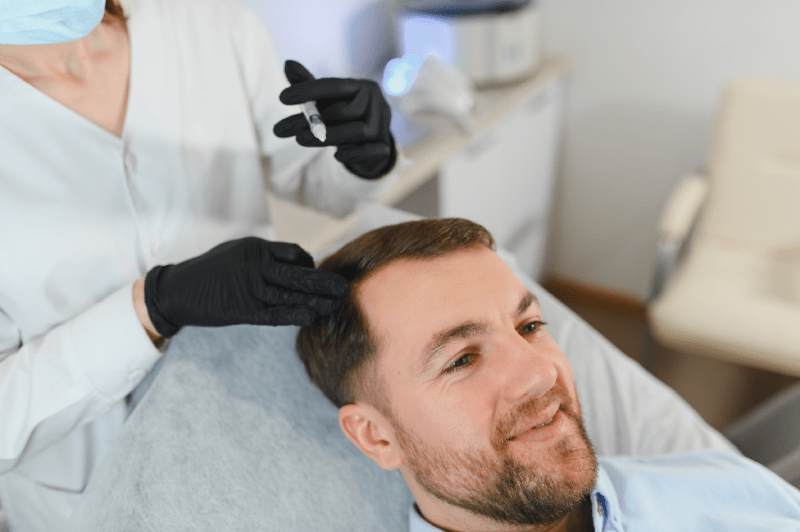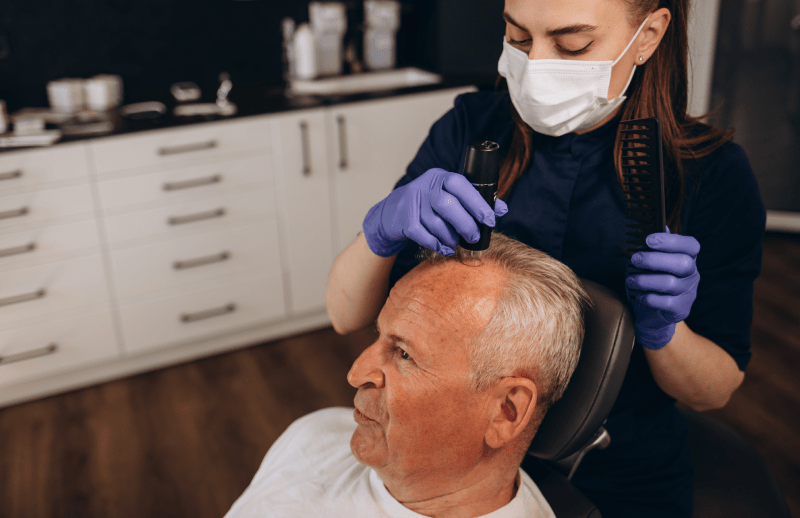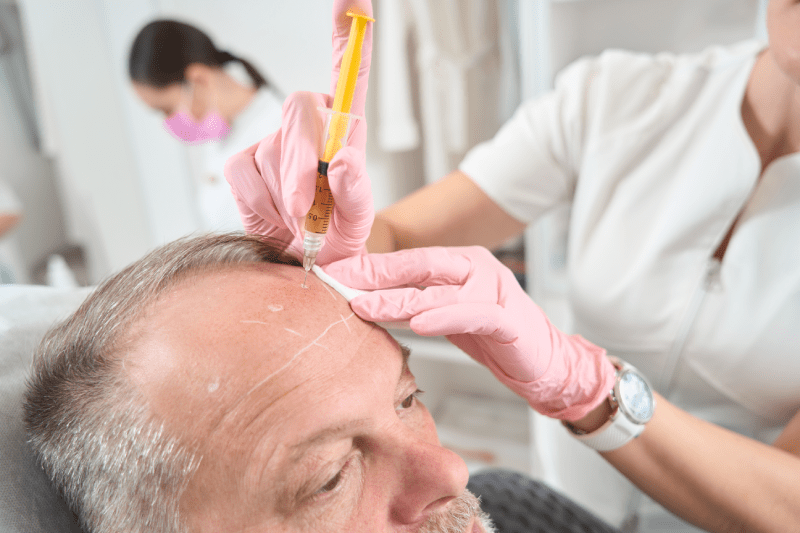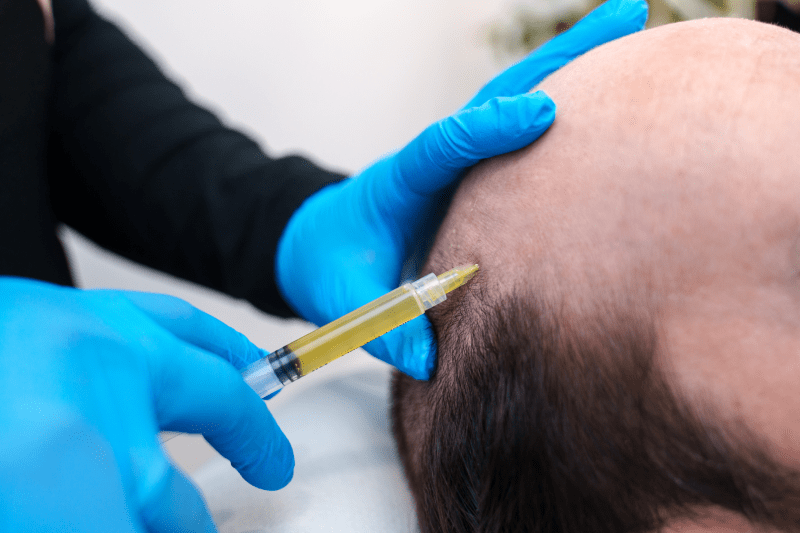Who Is The Most Suitable Candidate For Hair Transplantation In Women?
The most suitable candidates for hair transplantation in women are typically those who exhibit a male pattern hair loss (where there is thinning on the top of the head but healthy hair follicles remain at the nape and behind the ears) or individuals with hair loss resulting from trauma, scars, or face-lift surgeries.
Women experiencing widespread thinning (diffuse alopecia) may not always be good candidates due to donor area insufficiency. Specialists must ensure that hormonal and medical causes of hair loss are treated before deciding on a hair transplant. It is important to consult with a Cure Holiday advisor for a comprehensive analysis before starting treatment.
Why Does Female Hair Transplantation Require A Different Expertise Than Men’s?
Female hair transplantation requires a different expertise than men’s because women generally experience widespread thinning rather than completely bald areas, necessitating implantation among existing hairs. This situation requires greater sensitivity and the use of specialized techniques like DHI to avoid damaging existing roots during the procedure. Furthermore, hairline design in women requires softer, rounder, and aesthetically more curved lines compared to men. Offering the Non-Shaven transplantation option and being able to completely conceal the donor area are inseparable parts of this expertise.
Is Non-Shaven Hair Transplantation The Only Option For Women?
Non-shaven hair transplantation is the most psychologically preferred option for women due to the rapid return to social life, but it is not the only technical option. In non-shaven transplantation, the DHI (Direct Hair Implantation) technique is usually used, and only a limited donor area is shaved, while the recipient area remains unshaven. This method is costly and requires more labor. In women with very advanced thinning or those needing a high number of grafts, partially shaven or fully shaven FUE techniques, which are more cost-effective and allow for more root implantation, may also be recommended by specialists.
Why Is The Non-Shaven DHI Technique More Preferred In Women?
The Non-Shaven DHI (Direct Hair Implantation) technique is more preferred in women due to its aesthetic and privacy advantages. With this technique, grafts are placed directly between the existing hair follicles using implanter pens, and since the hair is not shaved, the operation marks can be immediately camouflaged. Considering women’s tendency to keep their hair long and not want the operation to be noticeable, DHI offers an ideal solution by being minimally invasive and shortening the return time to social life. However, since this delicate work takes longer, it can increase the package price.
How Long Does The Hair Transplant Operation Take In Women?
The duration of a hair transplant operation in women varies depending on the number of grafts to be implanted, the technique used, and the shaven/non-shaven preference. Generally, non-shaven DHI techniques require more precision and time, so the operation time is longer than standard FUE procedures. A comprehensive female hair transplant operation can typically last between 6 to 8 hours. This long duration is necessary to ensure each graft is carefully harvested and implanted at an angle that matches the existing hair direction. Regular breaks are provided during this long process for the patient’s comfort.
What Aesthetic Vision Does Hairline Design Require In Women?
Hairline design in women requires a softer, rounder, and less distinct aesthetic vision, in contrast to the straight and defined lines in men. Specialists focus on creating a natural frame by correcting the patient’s forehead height, facial proportions, and especially temporal recession. Using finer, single grafts in the frontal line and leaving slight irregularities ensures the hair will be combable and look completely natural when grown out. A successful design requires meticulous and artistic work that emphasizes the individual’s feminine facial features.
Do The Causes Of Hair Loss Affect The Transplant Outcome In Women?
Yes, the causes of hair loss in women directly affect the timing of the transplant operation and its eventual success. Active and treatable causes of shedding, such as Telogen Effluvium (temporary shedding due to stress or vitamin deficiency), must be controlled before transplantation. For hair loss other than Androgenetic Alopecia (male pattern hair loss), the quality and stability of the donor area may be compromised, so the decision to transplant must be made more carefully. Specialists mandate the treatment of underlying medical causes, such as hormonal imbalance or thyroid issues, before transplantation.
How Does Hormonal Balance Affect Hair Transplant Results?
Hormonal balance can seriously affect hair transplant results in women in the long term. Hormonal changes during Polycystic Ovary Syndrome (PCOS) or menopause can trigger hair loss and cause existing hairs around the transplanted areas to shed. Therefore, monitoring hormonal levels before and after the transplant and collaborating with endocrinology specialists when necessary is important. Stable hormonal levels ensure that both the roots taken from the donor area remain healthy and the survival rate of the transplanted roots is maximized.
What Are The Donor Area Limitations In Women?
Donor area limitations in women are generally more pronounced than in men. While shedding is limited to certain areas in men, in women, shedding can be more diffuse, which may lead to the donor area not being dense enough. Furthermore, due to women’s tendency to wear their hair long, harvesting a high number of grafts from the donor area can cause noticeable thinning in the nape region. For this reason, specialists take great care to harvest fewer but the highest quality roots in women and preserve the donor area.
Why Can Hair Transplant Prices Be Higher In Women?
Hair transplant prices in women can be higher than standard male FUE packages, usually due to the preferred non-shaven transplantation (Non-Shaven DHI) technique. The non-shaven procedure requires more surgical meticulousness, a longer operation time, and more staff working. Additionally, implanting hair in thinning areas in women requires more challenging craftsmanship, which also increases the cost. However, intermediaries like Cure Holiday can help balance this cost difference by offering high quality with affordable packages.
What Do All-Inclusive Packages Prepared For Women Include?
The “all-inclusive” hair transplant packages prepared for women are usually designed to provide VIP comfort alongside the operation. These packages typically include 3 nights and 4 days of luxury hotel accommodation, private transfers between the airport and clinic, needle-free anesthesia during the operation, and supplementary support like PRP treatment. Additionally, specially formulated shampoos, lotions, medications, and female interpreter support for international patients are included as standard in the package. This holistic approach meets the privacy and comfort expectations of female patients.
When Can Women Start Applying Makeup After A Hair Transplant?
Women can generally start applying makeup after a hair transplant from the third day onwards, provided they do not apply pressure to the operation area and minimize the risk of infection. However, makeup should only be applied to facial areas outside the transplant region. Foundation, concealer, or any cosmetic products should not be applied to the recipient and donor areas until the skin has completely healed and the scabs have shed (approximately 10-15 days). Maximum attention should be paid to hygiene during this period.

How Is The First Wash Procedure Different For Women After The Operation?
The first wash procedure after the operation requires more sensitive attention in women, especially if non-shaven transplantation was performed, as it also involves washing the existing long hair. The wash is performed by a professional team at the clinic 48-72 hours after the operation to guarantee the settling of the roots. Specialists soften the scabs with special lotions and gently rinse them with low-pressure water. Female patients are meticulously instructed to avoid pulling long hair or using harsh movements when washing at home, and to use only the soft pads of their fingertips.
When Can Hair Dyeing Or Chemical Treatments Be Done After A Hair Transplant?
Hair dyeing or chemical treatments (perm, blow-dry, etc.) should not be rushed after a hair transplant. Chemicals must be avoided until the skin in the transplanted area has completely healed and the roots have strengthened. Chemical procedures like hair dyeing are safe to be performed earliest two to three months after the transplant. However, specialists generally recommend waiting six months for dyes that directly contact the scalp. Only clinic-approved, chemical-free natural products should be used during this period.
Do Women Experience Shock Loss After A Hair Transplant?
Yes, women are also expected to experience shock loss after a hair transplant, just like men. This shedding usually occurs between the 2nd and 8th weeks after the operation and indicates that the transplanted hair follicles are entering the resting phase to make way for new and permanent hair. Female patients should manage the process knowing that this shedding is not permanent and that new, healthy hair will begin to emerge from the 3rd month. Cure Holiday consultants inform the patient during this natural process to prevent panic.
How Many Days Should Be Spent In Istanbul For Travel And Recovery?
The ideal duration for female patients to stay in Istanbul for the first critical stage of travel and recovery is three nights. During this period, patients undergo the operation, rest in the clinic or hotel on the first night, and have the most important stage, the first wash and detailed check-up, professionally performed on the third day. They can safely return home on the fourth day. Three nights provide enough time for the grafts to settle healthily and for the possible swelling from the operation to largely subside.
What Is The Best Age Range For Hair Transplantation In Women?
The best age range for hair transplantation in women is between 25 and 65, where the causes of hair loss are largely controlled and the hair loss pattern has stabilized. Especially in young patients under 25, transplants performed before the cause of shedding is fully understood can lead to new bald spots forming later and an unnatural appearance around the transplanted hair. Therefore, specialists recommend medical treatment first for young patients and waiting for the hair loss to stabilize.
What Are The Hair Care Products Used After Hair Transplantation?
The care products used after hair transplantation are specially formulated to support the healing process and maximize graft survival. These products usually include special shampoos with low pH, hypoallergenic, and chemical-free, and special lotions or foams that soften scabs and moisturize. These products help the scalp heal quickly while reducing the risk of infection. In quality packages, these care sets are provided to the patient free of charge for initial use.
How Does PRP Treatment Increase Hair Transplant Success In Women?
PRP (Platelet-Rich Plasma) treatment is highly effective in increasing hair transplant success in women. This plasma, obtained from the patient’s own blood and rich in concentrated growth factors, accelerates cell regeneration and can lower the shock loss rate when injected into the recipient area, increasing the nourishment of the transplanted roots. Furthermore, PRP also strengthens existing hair follicles, making the overall result of the operation look thicker, denser, and healthier. Therefore, PRP is generally offered as a standard supportive treatment in quality packages.
What Should The Hair Transplant Warranty Cover In Women?
The hair transplant warranty scope in women should include the lifelong permanence of the transplanted roots and a commitment to successful growth at a certain rate (generally 90% and above). This guarantee ensures the patient’s investment is protected, especially considering the higher cost of non-shaven transplantation. The warranty certificate must clearly state that free revision or supplementary sessions will be performed if the committed growth rate is not reached. The warranty is conditional on the patient following the doctor’s instructions.
Which Blood Tests Must Be Performed Before Hair Transplantation?
Mandatory blood tests before a hair transplant ensure the safety of both the patient and the surgical team. These tests include screening for infectious diseases (Hepatitis B, C, HIV), checking the blood’s clotting time (to manage the risk of bleeding during the operation), assessing anesthesia risks, and basic biochemistry values to detect possible hormonal imbalances (thyroid, iron deficiency). This comprehensive preliminary analysis ensures the operation is performed under the safest and healthiest conditions.

Is Pain Or Discomfort Felt During The Hair Transplant Procedure?
Pain or discomfort during the hair transplant procedure is minimal because the entire operation is performed under local anesthesia. Patients may only feel a very brief stinging sensation at the start of the anesthesia injections. The best clinics in Istanbul use needle-free anesthesia (with Sedation support) applications to eliminate even this initial pain. As a result, female patients undergo the entire process awake but comfortable and pain-free. Any mild post-operative pain or soreness is easily controlled with prescribed painkillers.
When Can Women Start Exercising After A Hair Transplant?
Women should be careful before starting to exercise after a hair transplant. Light walking and activities that do not cause sweating can be resumed after one week due to the settling of the hair follicles and the risk of infection. However, strenuous sports, cardio, or swimming that cause pressure, friction, or excessive sweating on the scalp must be strictly avoided for at least one month. Preventing sweating is critical to reduce the risk of infection to the grafts and ensure healthy anchoring.
Is The Number Of Grafts And Density Sufficient In Non-Shaven Transplantation?
In non-shaven transplantation (Non-Shaven DHI), generally a lower number of grafts (usually around 2500-3000 grafts) can be implanted compared to shaven FUE. This is due to the difficulty of the technique and the long labor time. However, since transplantation is performed at high density in the thinning areas commonly seen in women, even a limited number of grafts can provide an aesthetically satisfactory result. Specialists usually apply non-shaven transplantation only to small or medium-sized areas to ensure maximum density without risking the donor area.
What Is The Success Rate Of Implantation In Thinning Areas In Women?
The success rate of implantation in thinning areas (among existing hairs) in women is high, depending on the team’s experience and the technique. Techniques like DHI allow implantation at the correct angle and direction without damaging existing hair follicles. The main factor determining success is the expert team’s ability to match the density and angle of the hair follicles in the “recipient” area. Successful transplants solve the thinning problem while making the existing hair look fuller and denser.
How Long Does It Take For Hair Transplant Results To Fully Mature?
It usually takes between 12 to 18 months for hair transplant results in women to fully mature and reach their final natural appearance. The first 3-4 months in this process are generally the shock loss and waiting phase. Noticeable growth begins from the 6th month, and most of the hair emerges. However, the hair strands continue to thicken, strengthen, and gain their natural structure, reaching their final state after the 12th month. It is important to be patient and not neglect doctor follow-ups during this process.
Is Psychological Support Important After Hair Transplantation In Women?
Yes, psychological support after hair transplantation in women is as important as the aesthetic result. Hair loss often has a profound emotional impact on women. The shock loss period can create disappointment and anxiety in some women. The best clinics provide psychological support by ensuring reassuring and continuous communication with their patients during this challenging recovery process. Consulting services like Cure Holiday also help the patient navigate this process positively and consciously.
Which Techniques Are Used For A Natural And Dense Hair Appearance?
For a natural and dense hair appearance in women, Sapphire FUE and DHI (Direct Hair Implantation) techniques are generally used together or separately. Sapphire FUE reduces trauma in the recipient area by opening smaller and more precise channels, allowing for denser implantation. DHI increases the sense of fullness by enabling high-density implantation among existing hairs, especially in thinning areas. The key to success is not the technique used but the surgical team’s ability to combine these techniques with the correct hair direction and angle.
What Is The Relationship Between Hair Transplant Cost And Donor Area Quality?
There is a strong relationship between hair transplant cost and donor area quality. The better the donor area quality (density and hair strand thickness), the more natural and dense the result of the operation will be. Poor or insufficient donor area limits the number of implants and may require resorting to more costly and complex methods like revision or BHT (Body Hair Transplant) to achieve the desired density. Therefore, the first step when analyzing the cost is always a detailed analysis of the donor area.
Are Flight Tickets And Transfers Included In The Package For Female Hair Transplantation?
The “all-inclusive” packages offered for female hair transplantation generally include accommodation, VIP airport, and clinic transfers, while the flight ticket cost is excluded. Since flight ticket prices vary greatly based on personal preferences and travel dates, clinics keep this cost separate to maintain price transparency. However, health tourism consultants like Cure Holiday provide detailed support in planning the patient’s travel and finding the most suitable ticket options.
When Is Hair Cutting Safely Done After A Hair Transplant?
Hair cutting after a hair transplant should be done within a safe timeframe for the transplanted roots to fully anchor and the donor area to heal. Cutting with scissors (trimming only the ends) can generally be done safely after one month. However, it is strongly advised to wait at least three months for cutting with vibrating tools like clippers, razors, or blades. This prevents damage to the roots in both the donor and recipient areas and does not risk the healing process.
How Should Nutrition Be Before And After Hair Transplantation In Women?
Nutrition before and after hair transplantation in women is critical to maximizing healing and hair quality. Supplements with blood-thinning effects (Vitamin E, Omega-3) should be stopped before the operation. After the operation, a diet rich in protein, zinc, iron, and B vitamins (especially Biotin) (fish, eggs, green vegetables) is recommended. Drinking plenty of water also supports blood circulation and the nourishment of the roots. Healthy nutrition directly affects the quality of the grafts.

What Are The Special Advantages Offered By Istanbul Clinics For Women?
Istanbul clinics offer special advantages for women, such as the option of non-shaven DHI technique, female interpreter support, private VIP accommodation and transfers prioritizing privacy. Additionally, supplementary treatments like PRP and mesotherapy are often included in packages to support the post-operative recovery process. Istanbul’s highly competitive environment allows clinics to offer these comfort and aesthetic-focused services at affordable costs, providing the best options that meet female patients’ expectations.
How Is Interpreter Support Provided For Female Patients Coming From Abroad?
Interpreter support for female patients coming from abroad is generally a standard part of the clinic’s “all-inclusive” package and is provided without interruption. The interpreter is present at every stage, from meeting the patient at the airport, communicating with the doctor during the initial consultation, providing instructions in the operating room, and explaining the first wash instructions. Most of these interpreters are professionals with medical terminology expertise, and some clinics specifically employ female interpreters for the comfort of female patients. This support eliminates communication barriers and ensures the patient feels safe.
This guide clarifies all the details regarding the female hair transplant process in Istanbul, focusing especially on aesthetic and recovery comfort.
You can contact Cure Holiday experts to create a personalized, safe, and comfortable treatment plan and to receive transparent information about the best clinic options in Istanbul. They are here to find the most suitable package for you.


